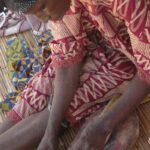As the means of securing a saddle to the horse, a girth strap needs to be strong and durable. 25 strands (ceeli) of leather are braided together to form a flat plaited strap in a style called zeppol (Image 1). Salamata does this with her bare hands, occasionally dabbing water onto the leather to make it easier to handle. After this she hammers it with a wooden pestle (nakadewal) to make the strap smooth, shiny and flexible. She takes a razor blade and trims off any raw ends protruding from the surface. Next she takes the heart of a millet stalk, called tewu yombal (which literally means stalk meat) and applies the dye to the surface (Image 2). Like much of the leather colouring and cutting, this is done on a wooden slate (aluwal). (On larger pieces of leather, dye is applied using a cloth wrapped around a stick or a dried corn cob).
The edges are finished in santala, which is a black dye made from metal soaked in water. After the colour is dry, Salamata finishes the surface by rubbing it with the nakadewal (Image 3). To back the girth, Husseini takes a strip of hand-woven cotton (bought from the market) and stitches it to the leather strap with a needle (battal) and thread (Image 4). To attach the buckle (made by a blacksmith), an extra strong piece of leather is needed. For this, Husseini buries a piece of untreated dried goat skin in the sand and leaves it to absorb moisture so it is easier to work with. If the sand is cold this may take two hours; if it is hot it may take a day but never longer as ants would destroy it. He cuts the skin into two rectangles and loops them through each buckle, attaching them to the ends of the girth. The stitches are made by threading fine leather strips through holes made with a skewer (sundiyare) (Image 5).







That’s a lot of hard earned work! Nothing beats handmade workmanship. The energy put into a product made from human hands is very valuable in more ways than one… My warmest thoughts and gratitude sent to these pure and humble people.